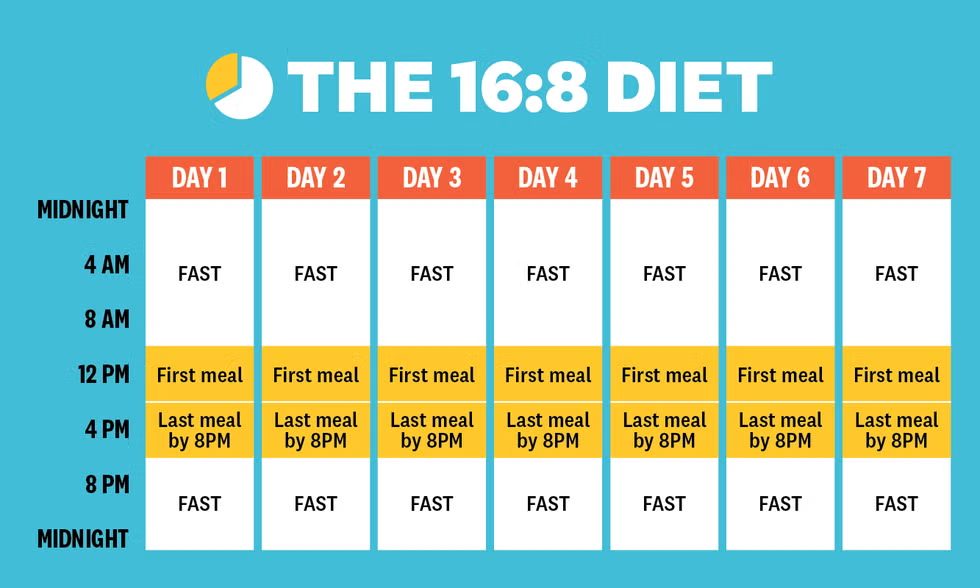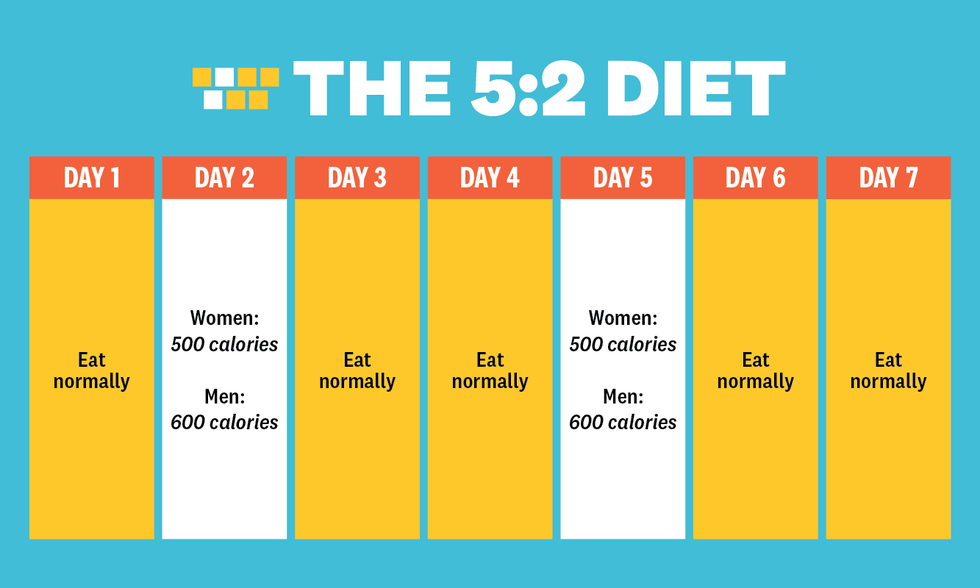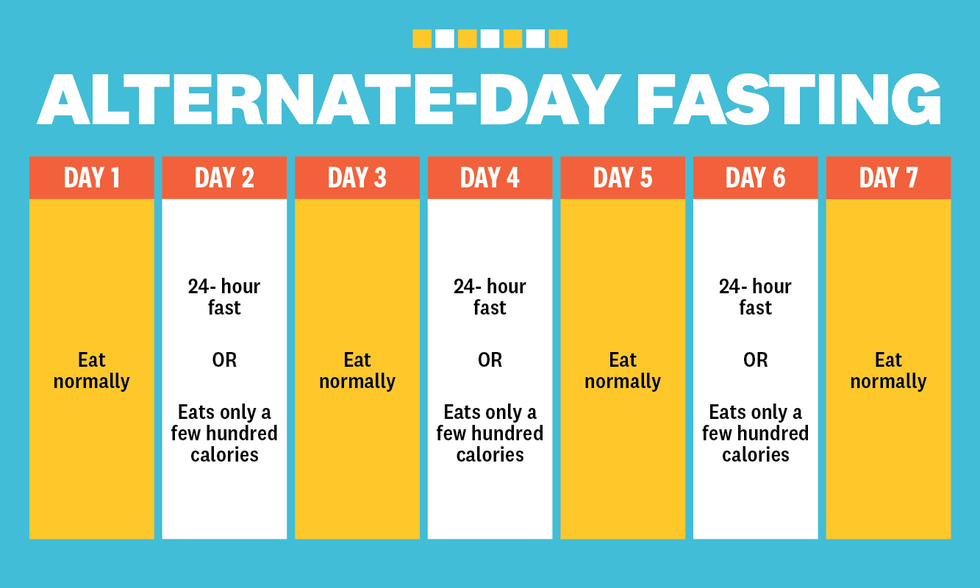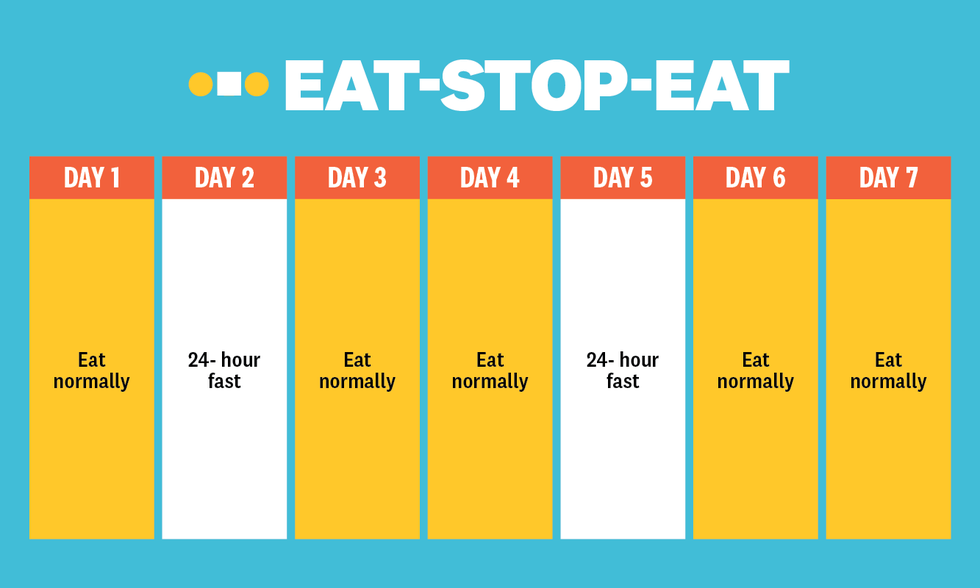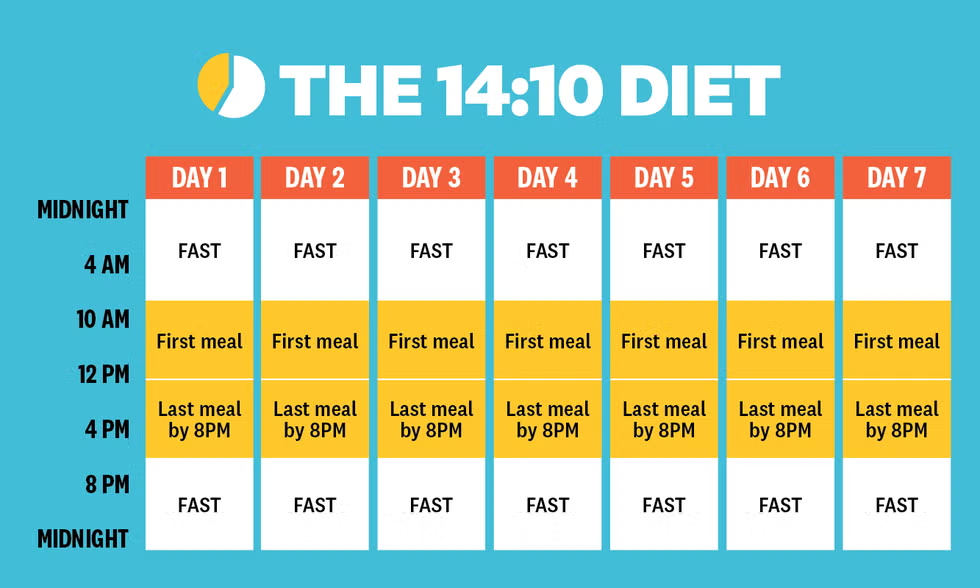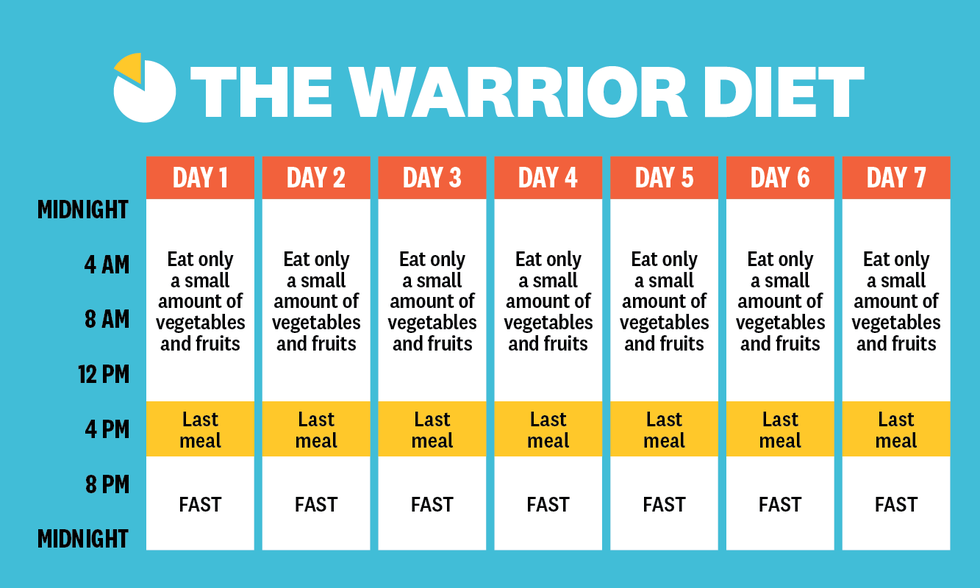Intermittent fasting (IF) has become a popular weight-loss tool for a reason: It has amassed a huge following over the years, including celebrities like Vanessa Hudgens and Halle Berry, who swear by this eating plan. There are many different ways to do it, though, and each intermittent fasting schedule works for different people.
ICYMI, intermittent fasting is a type of eating plan that alternates periods of eating and fasting in which you can only consume water, coffee, and tea. During your eating windows, you can generally have what you want, which is why the plan works for a lot of people.
There are plenty of benefits to back the hype of IF, but it is not for everyone, and the last thing you'd want to do is try sticking to a plan that feels impossible because it clashes with the structure of your day.
Intermittent fasting can be difficult to follow if you're the type who munches on smaller portions or snacks throughout the day. And it's definitely not a good idea for anyone with a history of disordered eating or diabetes and those who are pregnant or breastfeeding—even if weight loss is recommended, says Dana White, RD. And if your schedule is sporadic or you work out at various times of the day, you might also want to reconsider taking on IF.
But if you tend to overeat at night or are looking for a bit more discipline, intermittent fasting may help prevent mindless eating through the day. It might also be a good option if you've tried creating a calorie deficit in the past but it didn't work.
The 16:8 (more on that below) is the most popular method, according to White. But there are plenty of other options to choose from. Here are six of the most popular IF approaches that people tend to follow for weight loss—and exactly what the current research says about the potential benefits or concerns for each one. Really though, the most successful diet is one you can stick to, so the IF schedule that seems the easiest to follow is probably your best bet.
Meet the experts: Dana White, RD, is a nutritionist based in Connecticut. She specializes in culinary nutrition, recipe development, and sports nutrition.
Amanda Baker Lemein, RD, LDN is a Chicago-based nutritionist. She often works with clients to create meal plans and strategize healthy eating approaches for those with busy schedules.
1. The 16:8 diet
The 16:8 method of intermittent fasting involves fasting every day for 16 hours and restricting your daily eating window to eight hours. For most people, this schedule means not eating anything after dinner and skipping breakfast. You might eat between, say, noon and 8 p.m.
If you like to get your workouts done in the A.M., White suggests opting for a schedule that's more accommodating than this one (see the 14:10 diet). But if you prefer to get in your workouts during the late afternoon or after 5 p.m., you'll still have time to eat after your workout to refuel with a meal.
As far as how the 16:8 method fares for weight loss? It could work, the (very limited) research shows. In a small study published in the journal Nutrition and Healthy Aging, 23 obese men and women followed the 16:8 diet for 12 weeks. Compared to a group that had eaten normally and not within a set timeframe, those on the 16:8 diet took in 350 fewer calories per day, lost a modest amount of weight (about three percent of their body weight on average), and lowered their blood pressure. Still, it's important to note that this was a small study, and there isn't a ton of research on the 16:8 diet specifically, so it’s tough to say that following the 16:8 diet is a surefire way to shed excess weight.
Interestingly, following this kind of eating plan may help with appetite control. A 2019 study in the journal Obesity showed that people who ate only during a six-hour window versus those following a normal eating schedule felt less hungry, even though both groups ate the same amount of calories.
2. The 5:2 method
To follow the 5:2 diet, you eat normally five days a week and cut back to 20 percent of your normal daily calorie intake for the other two. Women are supposed to have about 500 calories on fasting days, while men have about 600. If you chose to move forward with this plan, make sure you're fueling up the day before you fast to avoid overeating when it's time to eat again.
You burn calories every minute you're alive, including when you're sleeping. When you snooze, your body utilizes the glycogen stored in your liver to keep your blood sugar levels stable. So your body is already familiar with the mechanisms of fasting, explains White.
"Your body is designed to compensate when energy is not coming in from food," she adds. "The concept of something like fasting is to prolong that period where you're relying on your internal backup system in order to fuel you."
This IF method results in just as much weight and fat loss as those who followed traditional dieting methods, according to a 2021 study published by PLOS ONE.
3. Alternate-day fasting
As the name implies, this diet involves fasting every other day. There are several different versions of this plan, with some of them allowing about 500 calories on the fasting days, and some encouraging that you eat even fewer or close to zero calories on fasting days.
Much of the weight loss-focused research hasn't been conclusive. A 2017 study in JAMA concluded that this style of intermittent fasting was not superior to a calorie-restricted diet in weight loss or maintenance.
IF schedules that require 24 hours of fasting are harder to stick to and people tend to experience more side effects, including mood swings and hunger, according to White. So, only try this if you have done IF before and are willing to track your calorie intake and cut down the intensity of your workouts on fasting days to avoid injury.
4. Eat-stop-eat diet
This method of intermittent fasting involves a full fast for 24 hours once or twice a week. For example, you may eat dinner at 6 p.m. and then fast until 6 p.m. the next day, and you would do this one or two times per week—but not in a row.
Keep in mind that not eating for an entire day can be dangerous under certain circumstances and should not be taken lightly. While the weight-loss potential might be appealing, skipping full days of eating is not sustainable long-term.
"If you are knocking out two full days of eating, I would worry that the longer you do that, the greater at risk you would be for certain micronutrients deficiencies," says White.
5. The 14:10 diet
This one is similar to the 16:8 method, but involves fasting for a 14-hour window and eating for 10. It's a little easier to stick to than 16:8 because you have a longer eating window. But that doesn't mean weight loss is impossible.
A 2021 study in Nutrition & Diabetes found that those who followed the 14:10 diet while incorporating nutritious foods and consistent exercise lost more weight than those who did the 12:12 diet. They also showed a more significant improvement in blood glucose levels after eight weeks.
Given that the fasting period is short and pretty much follows the way people already eat, it may be hard for some people to achieve a calorie deficit with this diet. Still, it could be a good way to ease into IF if you're new to it and just want to see how you do when you have a specific timeframe for eating and can't just snack whenever the mood strikes. It's also a great option if you like to get your workouts in between 8 a.m. and 10 a.m.
6. The Warrior Diet
This diet is way different from the rest, with the majority of eating happening at night. The Warrior Diet was coined by fitness author Ori Hofmekler. It involves eating only small portions of raw fruits and vegetables during the day, then feasting on one huge meal at night within a 4-hour eating window.
There's no specific research on the Warrior Diet, but since the fasting periods still allow for some food, it may be more practical for some people. Still, the period when you can have heavier foods is very short, and the diet also involves focusing on paleo foods, so it's stricter than other forms of IF.
However, like the eat-stop-eat diet, this option is not sustainable long-term. "There's no way you're going to meet your nutrient needs eating this little food," explains White. "Your energy levels would suffer and you're basically asking to overeat. You're just going to hurt yourself if you go this route."
What are the benefits of intermittent fasting?
Although there is limited research, the initial findings are promising. Here are the potential benefits of IF based on recent studies.
- IF can minimize insulin levels. It can also reduce fat mass and the risk of developing age-related diseases, according to a 2022 study in the Journal of Physiology and Biochemistry.
- IF may help prevent short-term and long-term memory loss, per a 2018 animal study in the journal Experimental Biology and Medicine.
- IF could aid in the treatment and prevention of obesity, per Wageningen Academic.
So which intermittent fasting schedule is best for weight loss? Whichever one you'll actually stick to, TBH.
In short, the one that's easiest for you to follow. "It is all about sustainability for the individual," says Amanda Baker Lemein, RD, a WH advisor. "If one of these diets work well for you and your lifestyle and preferences, then you will likely see some success. If not, then you'll likely not see the results you're are looking for, as the sustainability piece will not be there." That means picking a diet that work best with all the lifestyle factors you need to consider, like your work schedule, family dynamic, living situation, commute time, and travel commitments, notes Lemein.
It's worth pointing out, though, that the 16:8 diet seems to be the most doable for a lot of people who are into IF. The 16:8 method also scores points for preventing overeating at night, which can often be a big obstacle for weight loss. And sticking to an eight-hour eating window during daylight hours allows your metabolism to run as it’s supposed to—you fuel up for energy during the day (when you’re most active), and stop eating for rest and recovery at night, per a 2017 article in the journal Nutrition Reviews.
Of course, any weight loss that you experience from IF is most likely due to the basic fact that you're consuming less calories, not necessarily the timing of your eating, says Lemein. And you can totally eat less, and lose weight, without taking on fasting. Case in point: A meta-analysis published in the JBI Database of Systematic Reviews and Implementation Reports in 2018 found that intermittent fasting had similar weight loss results to a traditional calorie-restricted diet. So, unless fasting makes dieting easier for you, there's really no reason to chose IF over other diets.
The bottom line: All intermittent fasting schedules may lead to weight loss if you can follow them sustainably, and the 14:10 method may be the easiest way to follow an IF diet.

Sabrina is an editorial assistant for Women’s Health. When she’s not writing, you can find her running, training in mixed martial arts, or reading.

